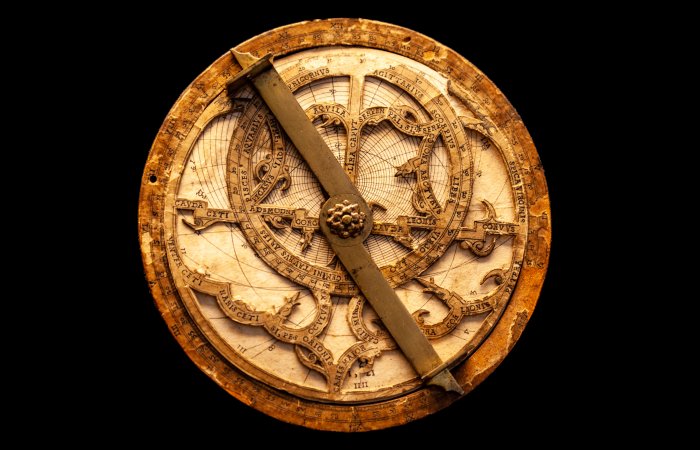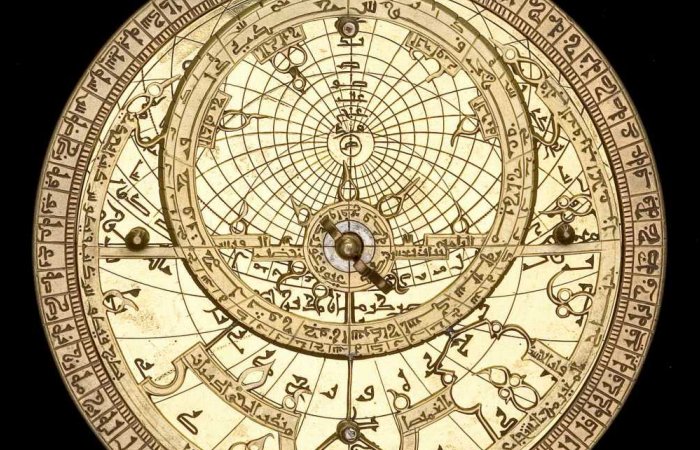Astrolabe: A Beautiful, Mysterious And Sophisticated Computer Of The Ancient World
A. Sutherland - AncientPages.com - The astrolabe is a beautiful ancient object. It is fair to say it is an instrument with a past and future. It is also a sophisticated ancient astronomical computer especially created for solving problems related to time and the position of the Sun and stars in the sky.
Credit: Adobe Stock - markrhiggins
In most cases, the astrolabes were made of brass and had a 6-inch diameter. Some of the objects were much larger.
The oldest astrolabes date back to two thousand years ago. Among the most popular types is the planispheric astrolabe, on which the celestial sphere is projected onto the plane of the equator. Despite being created at a time when people thought that the Earth was the center of the universe, the astrolabe is a useful ancient tool.
The object operates on the same basis as any other modern computer. You provide it with data, that is, input information, and then you receive output.
Ancient people used astrolabes to find out how the sky looked at a specific place at a given time. It was done by drawing the sky on the face of the astrolabe and marking it, so positions in the sky were easy to find.
An 18th Century Persian astrolabe–maker unknown. The points of the curved spikes on the front rete plate, mark the positions of the brightest stars. The name of each star being labeled at the base of each spike. The backplate or mater is engraved with projected coordinate lines. From the Whipple Museum of the History of Science in Cambridge. Image credit: Andrew Dunn - CC BY-SA 2.0
To use an astrolabe, you adjust the moveable components to a specific date and time. Once set, much of the sky, both visible and invisible, is represented on the face of the instrument.
This clever ancient computer was mainly used to find the time during the day or night, the time of a celestial event such as sunrise or sunset, and as a reference for stellar positions.
During the late Middle Ages, it served as a primary education astronomy tool and was sometimes even used for astrological purposes.
The typical astrolabe was not a navigational instrument. However, the mariner's astrolabe was widely used in the Renaissance. The device can measure the altitude above the horizon of a celestial body, day or night, identify stars and planets, determine local latitude on land or calm seas, and survey.
Astrolabe made between 1081 and 1082. Credit: History of Science Museum - CC BY-SA 4.0
The astrolabe was important in classical antiquity, the Islamic Golden Age, and the European Middle Ages. The name 'astrolabium' refers to the so-called prismatic astrolabe, invented by the French astronomer André Danjon.
The early astrolabe was invented in the Hellenistic civilization by Apollonius of Perga between 220 and 150 BC, often attributed to Hipparchus, a Greek mathematician, geographer, and astronomer who lived in the 2nd century BC. The essential part of the astrolabe is a brass plate with the lines of the celestial body's height above the horizon. It also has azimuth lines, and the hour wheels were engraved. Through the center of the plate was a line marking the north pole of the sky.
Hypatia (c. 350–370; died 415 AD), a great ancient scholar, built many astrolabes, but she did not invent them. The astrolabe was already in use at least 500 years before Hypatia was born.
Today, the astrolabe is still admired for its beauty and appreciated for its unique capabilities and its value for astronomy education.
Written by – A. Sutherland - AncientPages.com Senior Staff Writer
Updated on March 4, 2024
Copyright © AncientPages.com All rights reserved. This material may not be published, broadcast, rewritten or redistributed in whole or part without the express written permission of AncientPages.com
Expand for referencesMore From Ancient Pages
-
 Satellites Discover Over 160 Hidden Ancient Mounds In North America
Archaeology | Aug 2, 2018
Satellites Discover Over 160 Hidden Ancient Mounds In North America
Archaeology | Aug 2, 2018 -
 Life And Legacy Of Queen Tiye, Mother Of Akhenaten – Was She Egyptian Or Nubian?
Featured Stories | Jul 20, 2018
Life And Legacy Of Queen Tiye, Mother Of Akhenaten – Was She Egyptian Or Nubian?
Featured Stories | Jul 20, 2018 -
 Ancient Unsolved Mysteries Of Siberia – A Place Full Of Secrets
Featured Stories | May 19, 2014
Ancient Unsolved Mysteries Of Siberia – A Place Full Of Secrets
Featured Stories | May 19, 2014 -
 Ancient Highways Unearthed In Arabia
Archaeology | Jan 14, 2022
Ancient Highways Unearthed In Arabia
Archaeology | Jan 14, 2022 -
 On This Day In History: Mathematician And Astronomer Simon Marius Independently Rediscovered Andromeda Galaxy – On Dec 15, 1612
News | Dec 15, 2016
On This Day In History: Mathematician And Astronomer Simon Marius Independently Rediscovered Andromeda Galaxy – On Dec 15, 1612
News | Dec 15, 2016 -
 Many Roman Citizens Joined The Huns And Preferred Their Nomadic Lifestyle – New Study
Archaeology | Apr 4, 2017
Many Roman Citizens Joined The Huns And Preferred Their Nomadic Lifestyle – New Study
Archaeology | Apr 4, 2017 -
 Evidence Ancient Civilizations Had Knowledge About Planets In Our Solar System Thousand Years Ago
Featured Stories | Mar 10, 2021
Evidence Ancient Civilizations Had Knowledge About Planets In Our Solar System Thousand Years Ago
Featured Stories | Mar 10, 2021 -
 Mysterious Ancient Human ‘Ghost’ Species Discovered With Help Of Saliva
Archaeology | Jul 25, 2017
Mysterious Ancient Human ‘Ghost’ Species Discovered With Help Of Saliva
Archaeology | Jul 25, 2017 -
 Underwater Nabataean Temple With Marble Altars Discovered In Pozzuoli
Archaeology | Apr 12, 2023
Underwater Nabataean Temple With Marble Altars Discovered In Pozzuoli
Archaeology | Apr 12, 2023 -
 Unexplained Mystery Of The Glowing Woman Who Baffled Scientists
Featured Stories | Jun 6, 2022
Unexplained Mystery Of The Glowing Woman Who Baffled Scientists
Featured Stories | Jun 6, 2022 -
 On This Day In History: Spanish Villasur Expedition Wiped Out By Pawnee And Otoe Warriors – On August 14, 1720
News | Aug 14, 2016
On This Day In History: Spanish Villasur Expedition Wiped Out By Pawnee And Otoe Warriors – On August 14, 1720
News | Aug 14, 2016 -
 Race Against Time: Crucial Expedition To Delve Into Bouldnor Cliff, Europe’s Mesolithic Underwater Stone Age Site
Underwater Discoveries | Apr 28, 2024
Race Against Time: Crucial Expedition To Delve Into Bouldnor Cliff, Europe’s Mesolithic Underwater Stone Age Site
Underwater Discoveries | Apr 28, 2024 -
 Was Tintagel Castle A Fortress Used By Iconic Hero King Arthur?
Featured Stories | Mar 12, 2016
Was Tintagel Castle A Fortress Used By Iconic Hero King Arthur?
Featured Stories | Mar 12, 2016 -
 What Can The Fate Of Ancient Cities Teach Us About Surviving Climate Change
Archaeology | Oct 1, 2021
What Can The Fate Of Ancient Cities Teach Us About Surviving Climate Change
Archaeology | Oct 1, 2021 -
 Mawangdui Medical Manuscripts: Oldest Surviving Anatomical Atlas In The World
News | Sep 2, 2020
Mawangdui Medical Manuscripts: Oldest Surviving Anatomical Atlas In The World
News | Sep 2, 2020 -
 Salt Workers’ Residences At Underwater Maya Site – Identified
Archaeology | Nov 22, 2021
Salt Workers’ Residences At Underwater Maya Site – Identified
Archaeology | Nov 22, 2021 -
 Strange Bodies And Skulls Of Ancient Unknown Mighty Warriors Found In Virginia
Featured Stories | Sep 10, 2024
Strange Bodies And Skulls Of Ancient Unknown Mighty Warriors Found In Virginia
Featured Stories | Sep 10, 2024 -
 Rare Viking Artifacts Hidden Beneath The Ice Discovered By Archaeologists In Norway
Archaeology | Feb 6, 2021
Rare Viking Artifacts Hidden Beneath The Ice Discovered By Archaeologists In Norway
Archaeology | Feb 6, 2021 -
 Boxer At Rest – Rare Sculpture And Masterpiece Of Hellenistic Bronze Art
Artifacts | May 21, 2021
Boxer At Rest – Rare Sculpture And Masterpiece Of Hellenistic Bronze Art
Artifacts | May 21, 2021 -
 Library Of Celsus: Beautiful Classic Monument In Ephesus That Stored 12,000 Scrolls
Civilizations | Nov 14, 2018
Library Of Celsus: Beautiful Classic Monument In Ephesus That Stored 12,000 Scrolls
Civilizations | Nov 14, 2018



